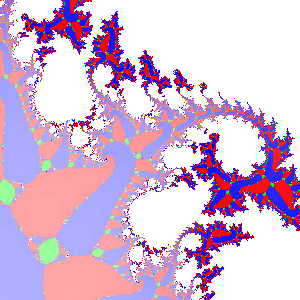
Newton Basins
David E. Joyce

Clark University
August, 1994
Table of contents
- Introduction (this is it)
- Background on Newton's method
- Some examples
- Generation form
- Technical details
- References in books and on the web
Newton's method for finding solutions to equations leads to some fantastic images when it's applied to complex functions. You start with an initial guess for the solution which may be any number, and the method gives you a closer estimate to the solution. The next estimate will be even closer. Anyway, that's what often happens.
Typically, there's more than one solution to the equation. If you start near one solution, you'll quickly get to it. But what happens if you start somewhere between two solutions? That's when you get interesting pictures. Color the complex plane according to where an initial guess will eventually take you. Give each solution a different color so that all the initial guesses that eventually eventually lead you to one to that solution are colored the same. A Newton basin is just the set of initial guesses that lead to one solution.
 What's interesting is that Newton basins are fractals! They aren't just blobs in the complex plane, but have beautifully intricate boundaries. In fact, they are kinds of Julia sets.
What's interesting is that Newton basins are fractals! They aren't just blobs in the complex plane, but have beautifully intricate boundaries. In fact, they are kinds of Julia sets.
Look over the background on Newton's method if you'd like to understand more about the mathematics involved. Browse some examples for a quick idea of the possibilities. Then create your own images of Newton basins with the generation form which allows you to see Newton basins for polynomials.
copyright © 1994, 1997.
The address of this file is http://aleph0.clarku.edu/~djoyce/newton/newton.html



 What's interesting is that Newton basins are fractals! They aren't just blobs in the complex plane, but have beautifully intricate boundaries. In fact, they are kinds of Julia sets.
What's interesting is that Newton basins are fractals! They aren't just blobs in the complex plane, but have beautifully intricate boundaries. In fact, they are kinds of Julia sets.